 |
|---|
|
|

Departments of Ivory Coast (French: départements de Côte d'Ivoire) are currently the third-level administrative subdivision of the country. Each of the 31 second-level regions of Ivory Coast is divided into two or more departments. (The autonomous districts are containing departments, but have a specific status.) Each department is divided into two or more sub-prefectures. Since 2020, there are 109 departments of Ivory Coast.
Departments were first created in 1959.[1][2] During their existence, they have been first-, second-, and third-level administrative subdivisions.
Current departments
[edit]
There are currently 111 departments of Ivory Coast. The departments are as follows:
- Abengourou
- Abidjan
- Aboisso
- Adzopé
- Agboville
- Agnibilékrou
- Bangolo
- Béoumi
- Biankouma
- Bondoukou
- Bongouanou
- Bouaflé
- Bouaké
- Bouna
- Boundiali
- Dabakala
- Daloa
- Danané
- Daoukro
- Dimbokro
- Divo
- Duékoué
- Ferkessédougou
- Gagnoa
- Grand-Lahou
- Guiglo
- Issia
- Katiola
- Korhogo
- Lakota
- Man
- Mankono
- M’Bahiakro
- Odienné
- Oumé
- Sakassou
- San-Pedro
- Sassandra
- Séguéla
- Sinfra
- Soubré
- Tabou
- Transua
- Tengréla
- Tiassalé
- Touba
- Toumodi
- Vavoua
- Yamoussoukro
- Zuénoula
- Adiaké
- Alépé
- Bocanda
- Dabou
- Grand-Bassam
- Jacqueville
- Tiébissou
- Toulépleu
- Bloléquin
- Akoupé
- Didiévi
- Kouibly
- Nassian
- Prikro
- Sikensi
- Zouan-Hounien
- Madinani
- Minignan
- Kounahiri
- Koun-Fao
- Arrah
- Attiégouakro
- Bettié
- Botro
- Dikodougou
- Doropo
- Fresco
- Guéyo
- Guitry
- Kani
- Kaniasso
- Koro
- Kouto
- M’Batto
- Niakaramadougou
- Ouangolodougou
- Ouaninou
- Samatiguila
- Sandégué
- Sinématiali
- Téhini
- Tiapoum
- Tanda
- Yakassé-Attobrou
- Zoukougbeu
- Buyo
- Dianra
- Djékanou
- Facobly
- Gbéléban
- Kong
- Kouassi-Kouassikro
- M’Bengué
- Méagui
- Séguélon
- Sipilou
- Taabo
- Taï
- Ouellé
- Bonon
- Gohitafla
History
[edit]1961–69
[edit]

Departments were established in 1961 and were the original first-level administrative subdivision of independent Ivory Coast.[3] Initially, there were just four departments: Centre, Nord, Sud-Est, and Sud-Ouest. In 1963, two more departments were created: Est was created by dividing Sud-Est, and Centre-Ouest) was created by dividing Sud-Ouest. As a result of the divisions, Sud-Est was renamed Sud and Sud-Ouest was renamed Ouest.
1969: 24 new departments
[edit]In 1969, the six departments were abolished and in their place 24 new departments were created. The following table illustrates how the old departments were divided into the new departments:

| Old department | New departments (number corresponds to position on map) |
|---|---|
| Centre | Bouaflé (8), Bouaké (9), Dimbokro (13), Katiola (18) |
| Centre-Ouest | Daloa (11), Gagnoa (16), Sassandra[4] (22) |
| Est | Abengourou (1), Bondoukou (7) |
| Nord | Boundiali (10), Ferkessédougou (15), Korhogo (19), Odienné (21), Séguéla (23), Touba (24) |
| Ouest | Biankouma (6), Danané (12), Guiglo (17), Man (20) |
| Sud | Abidjan (2), Aboisso (3), Adzopé (4), Agboville (5), Divo (14), Sassandra[4] (22) |
Due to a lack of government resources, the 1969 changes were not fully implemented until 1974.
Subsequent divisions and relegation to second-level
[edit]From 1974 onward, new departments were occasionally created through division of pre-existing departments. New departments were created in 1974 (2), 1980 (8), 1988 (15), and 1995 (1). In 1997, when there were 50 departments, regions were created, which supplanted departments as the first-level administrative subdivision. As a result, the 50 departments became second-level divisions.
More departments were created in 1998 (8), 2005 (12), 2008 (11), and 2009 (9). By the time of the late-2011 reorganisation of the subdivisions of Ivory Coast, there were 90 departments in 19 regions.
2011 subdivision reorganisation
[edit]In the 2011 reorganisation of the subdivisions of Ivory Coast, five new departments were created, bringing the total to 95. More significantly, however, districts were created as a new first-level division. As a result, regions became second-level subdivisions and the 95 departments became third-level subdivisions.
Post-2011 changes
[edit]Since the 2011 reorganisation, 14 more departments have been created, bringing the total number to 109. Twelve departments were created in 2012, one in 2013, and one was created in 2020.
Names and governance
[edit]Departments are named after the city or town that serves as the seat of the department. In most cases, this is the most populous settlement in the department.
Each department is headed by a prefect, who is appointed by the council of ministers (cabinet) of the national government.[5] For departments that house regional capitals, the prefect of the department is the same individual as the prefect of the region, though the two offices of prefect remain distinct.[6]
Each department is divided into two or more sub-prefectures, which serve as fourth-level administrative subdivisions. There are currently 510 sub-prefectures in the country.
Current departments by district and region
[edit]Below are the departments divided by district and region with the establishment year of the departments in parentheses.
- Abidjan Department[7] (1969)
- Fresco Department (2008)
- Sassandra Department (1969)
- Buyo Department (2012)
- Guéyo Department (2008)
- Méagui Department (2012)
- Soubré Department (1980)
- San-Pédro Department (1988)
- Tabou Department (1988)
- Abengourou Department (1969)
- Agnibilékrou Department (1995)
- Bettié Department (2008)
- Aboisso Department (1969)
- Adiaké Department (1998)
- Grand-Bassam Department (1998)
- Tiapoum Department (2008)
- Kaniasso Department (2011)
- Minignan Department (2005)
- Gbéléban Department (2012)
- Madinani Department (2005)
- Odienné Department (1969)
- Samatiguila Department (2009)
- Séguélon Department (2012)
- Gagnoa Department (1969)
- Oumé Department (1980)
- Divo Department (1969)
- Guitry Department (2009)
- Lakota Department (1980)
- Didiévi Department (2005)
- Djékanou Department (2012)
- Tiébissou Department (1998)
- Toumodi Department (1988)
- Daoukro Department (1988)
- M'Bahiakro Department (1988)
- Ouellé Department (2020)
- Prikro Department (2005)
- Arrah Department (2009)
- Bongouanou Department (1980)
- M'Batto Department (2009)
- Bocanda Department (1998)
- Dimbokro Department (1969)
- Kouassi-Kouassikro Department (2012)
- Agboville Department (1969)
- Sikensi Department (2005)
- Taabo Department (2012)
- Tiassalé Department (1988)
- Dabou Department (1998)
- Grand-Lahou Department (1988)
- Jacqueville Department (1998)
- Adzopé Department (1969)
- Akoupé Department (2005)
- Alépé Department (1998)
- Yakassé-Attobrou Department (2008)
- Bloléquin Department (2005)
- Guiglo Department (1969)
- Taï Department (2013)
- Toulépleu Department (1998)
- Bangolo Department (1988)
- Duékoué Department (1988)
- Facobly Department (2012)
- Kouibly Department (2005)
- Biankouma Department (1969)
- Danané Department (1969)
- Man Department (1969)
- Sipilou Department (2012)
- Zouan-Hounien Department (2005)
- Daloa Department (1969)
- Issia Department (1980)
- Vavoua Department (1988)
- Zoukougbeu Department (2008)
- Bonon Department (2020)
- Bouaflé Department (1969)
- Gohitafla Department (2020)
- Sinfra Department (1988)
- Zuénoula Department (1980)
- Boundiali Department (1969)
- Kouto Department (2008)
- Tengréla Department (1980)
- Dikodougou Department (2011)
- Korhogo Department (1969)
- M'Bengué Department (2012)
- Sinématiali Department (2008)
- Ferkessédougou Department (1969)
- Kong Department (2012)
- Ouangolodougou Department (2008)
- Béoumi Department (1988)
- Botro Department (2008)
- Bouaké Department (1969)
- Sakassou Department (1988)
- Dabakala Department (1974)
- Katiola Department (1969)
- Niakaramandougou Department (2009)
- Koro Department (2008)
- Ouaninou Department (2011)
- Touba Department (1969)
- Dianra Department (2012)
- Kounahiri Department (2005)
- Mankono Department (1980)
- Kani Department (2009)
- Séguéla Department (1969)
- Attiégouakro Department (2009)
- Yamoussoukro Department (1988)
- Bouna Department (1974)
- Doropo Department (2011)
- Nassian Department (2005)
- Téhini Department (2011)
- Bondoukou Department (1969)
- Koun-Fao Department (2005)
- Sandégué Department (2009)
- Tanda Department (1988)
- Transua Department (2009)
Defunct departments
[edit]There are six departments of Ivory Coast that have been eliminated.
- Centre Department (1961–69)
- Centre-Ouest Department (1963–69)
- Est Department (1963–69)
- Nord Department (1961–69)
- Ouest Department (1961–69)
- Sud Department (1961–69)
Maps of departments through time
[edit]| Map | Years effective | First-level subdivisions | Second-level subdivisions | Third-level subdivisions | Changes |
|---|---|---|---|---|---|
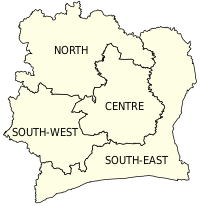
|
1961–1963 | 4 departments | — | — | Four departments created as first-level subdivisions. |
| 1963 (February) | 5 departments | — | — | One department added (Sud-Ouest and Sud-Est split into Ouest, Sud, and Est). | |
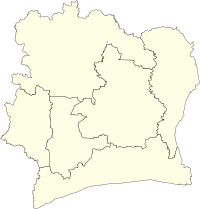
|
1963–1969 | 6 departments | — | — | One department added (Ouest split into Ouest and Centre-Ouest). |

|
1969–1974 | 24 departments | — | — | All previous departments abolished. 24 new departments established as first-level subdivisions. |

|
1974–1975 | 25 departments | — | — | One department added (Bouna). |

|
1975–1979 | 26 departments | — | — | One department added (Dabakala). |

|
1980–1987 | 34 departments | — | — | 8 departments added. |

|
1988–1991 | 49 departments | — | — | 15 departments added. |

|
1991–1995 | 10 regions | 49 departments | — | Regions established. |

|
1995–1996 | 10 regions | 50 departments | — | One department added (Agnibilékrou). |

|
1996–1997 | 12 regions | 55 departments | — | 2 regions and 5 departments added. |

|
1997–2000 | 16 regions | 59 departments | — | 2 regions and 4 departments added. |

|
1997–2000 | 19 regions | 59 departments | — | 3 regions added. |
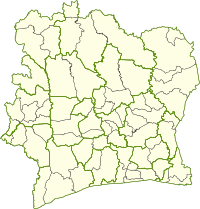
|
2005–2006 | 19 regions | 70 departments | — | 11 departments added. |

|
2006–2008 | 19 regions | 72 departments | — | 2 departments added. |

|
2008–2009 | 19 regions | 89 departments | — | 17 departments added. |

|
2009–2010 | 19 regions | 94 departments | — | 5 departments added. |

|
2010–2011 | 19 regions | 95 departments | — | 1 department added. |
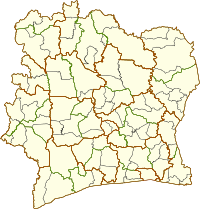
|
2011–2012 | 12 districts | 30 regions | 95 departments | Districts created as new 1st level division. New division of regions. |
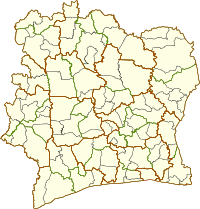
|
2012–2013 | 12 districts | 31 regions | 107 departments | 1 region and 12 departments added. |

|
2013–2014 | 12 districts | 31 regions | 108 departments | 1 department added. |

|
2014–2020 | 31 regions and 2 autonomous districts | 108 departments | — | Districts removed. |

|
2020– | 31 regions and 2 autonomous districts | 109 departments | — | One department added. |
Notes
[edit]- ^ Sato (2003).
- ^ Tice (1974).
- ^ At independence in 1960, Ivory Coast was informally divided into 19 traditional cercles, but the cercles were not official administrative subdivisions.
- ^ a b Sassandra Department was created from territory taken partly from Centre-Ouest Department and partly from Sud Department.
- ^ Loi n° 2014-451 du 05 août 2014 portant orientation de l'organisation générale de l'Administration Territoriale.
- ^ Ordonnance n° 2011-262 du 28 septembre 2011 portant orientation de l'organisation générale de l'administration territoriale de l'Etat Archived 2021-09-17 at the Wayback Machine.
- ^ The boundaries of Abidjan Department and Abidjan Autonomous District are the same.
References
[edit]- SATO Akira (2003). "L'évolution historique de la subdivision territoriale administrative en Côte d'Ivoire" in L'administration locale en Côte d'Ivoire. Africa Research Studies 10. 日本貿易振興機構(ジェトロ)アジア経済研究所 / Institute of Developing Economies, Japan External Trade Organization (IDE-JETRO). 2003. On-line.
- TICE Robert D. (1974). "Administrative Structure, Ethnicity, and Nation-Building in the Ivory Coast" in The Journal of Modern African Studies. 12, 2 (1974). pp. 211–29. (Jstor:https://www.jstor.org/stable/159720).
- "Regions of Côte d'Ivoire (Ivory Coast)", statoids.com, accessed 18 February 2016. [Outdated and with many wrong statements compared to Sato (2003) comprehensive study.]
- Carte du nouveau découpage administratif de la Côte-d'Ivoire (novembre 2011). [Outdated.]
- Décret n°2012-612 de 4 juillet 2012 portant creation de la Region du Moronou Archived 2021-09-17 at the Wayback Machine, page 86.
- Loi n°2012-1128 du 13 décembre 2012 portant organisation des collectivités territoriales Archived 2016-03-03 at the Wayback Machine
